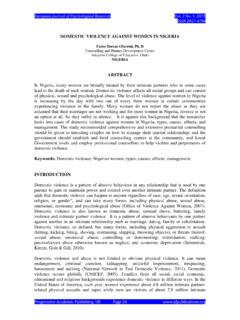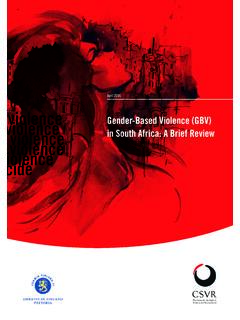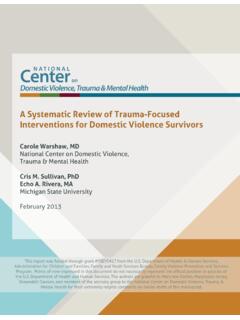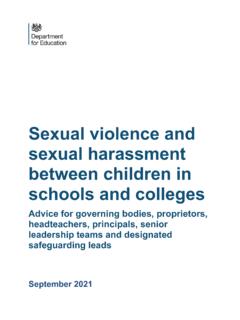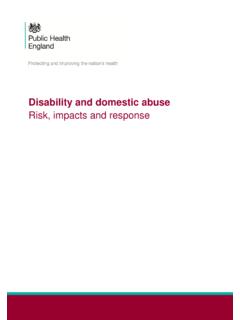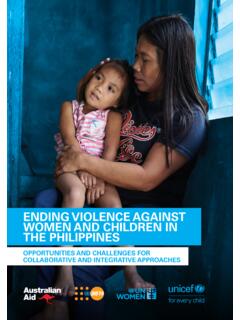Transcription of PREVENTING AND RESPONDING TO DOMESTIC VIOLENCE
1 PREVENTING AND RESPONDING TO DOMESTIC VIOLENCEH anoi 2011( Edition 2 )TRAINEE S MANUALG eneral Department of Anti-crime Police, MPS Administrative-Criminal Law Department, MOJ FOR LAW ENFORCEMENT AND JUSTICE SECTORS IN VIET NAMTRAINING FOR LAW ENFORCEMENT AND JUSTICE SECTORS General Department of Anti-crime Police, MPS Administrative-Criminal Law Department, MOJ ON DEALING WITH CASES OF DOMESTIC VIOLENCETRAINING FOR LAW ENFORCEMENT AND JUSTICE SECTORS General Department of Anti-crime Police, MPS Administrative-Criminal Law Department, MOJ ON DEALING WITH CASES OF DOMESTIC VIOLENCEA cknowledgementsThis training manual was developed in the framework of UNODC project Strengthening capacity of law enforcement and justice sectors to prevent and respond to DOMESTIC VIOLENCE in Viet Nam (VNM/T28). The manual is based on the the Handbook on effective police responses to VIOLENCE against women published by UNODC in Vienna 2010.
2 The UNODC project is funded by the Swiss Agency for Development and Co-operation (SDC), the Government of the United States of America and the Spanish Millennium Development Goal Achievement Fund through the UN-Government Joint Programme on Gender Equality. UNODC would like to extend special thanks to Ms. Eileen Skinnider for drafting the training manual. Ms. Skinnider was supported by experts from the Ministry of Public Security (Mr. Le Huu Anh), the Ministry Of Justice (Ms. Do Thuy Van) and the Court College (Mr. Cao Viet Hoang) throughout the drafting process, and their valuable inputs were much appreciated. The UNODC Viet Nam project team providing support in the development of the manual consisted of Ms. Jenni Viitala, Mr. Nguyen Tuan Anh, Ms. Daria Hagemann, Ms. Phan Minh Chau, Ms. Nhu Thi Minh Nguyet, Mr. Nguyen Hoa Chi and Ms.
3 Tran Thi Thanh Van. CONTENTT able of content MODULE 1:11 introduction : TRAINING FOR LAW ENFORCEMENT AND JUSTICE OFFICERS ON DEALING WITH DOMESTIC VIOLENCE IN VIETNAM 11 Section 1: Background and purpose of the training manual 13 Section 2: Setting the context 15 MODULE 2: 19 Understanding gender equality and DOMESTIC VIOLENCE 19 Section 1: Understanding the link between gender equality and DOMESTIC VIOLENCE 21 Section 2: The concept of gender and gender equality 21 Section 3: Defining DOMESTIC VIOLENCE 24 Section 4: Myths and realities about DOMESTIC VIOLENCE 28 Section 5: Understanding the cycle of VIOLENCE 30 Section 6: Consequences of DOMESTIC VIOLENCE 32 Section 7: Summary of key points 34 MODULE 3: 35 The legal framework for RESPONDING to DOMESTIC VIOLENCE in Viet Nam 35 Section 1: Relevant international standards 37 Section 2: Legislative framework in Viet Nam 40 Section 3: Legal procedure 51 Section 4: Responsible agencies 58 MODULE 4: 87 First responders to DOMESTIC VIOLENCE cases 87 Section 1: RESPONDING to DOMESTIC VIOLENCE as a first responder - An Overview 89 Section 2: RESPONDING to DOMESTIC VIOLENCE - Receiving initial information 90 Section 3: Arrival at the scene of DOMESTIC VIOLENCE 91 Section 4: Evidentiary issues 92 Section 5: Initial assessment of DOMESTIC VIOLENCE cases 101 Section 6: Documentation and file management 104 Section 7: Protection of victims and victim support 107 MODULE 5: 113 The administrative sanction system and DOMESTIC VIOLENCE 113 Section 1: Overview of the administrative sanction system in RESPONDING to DOMESTIC VIOLENCE 115 Section 2.
4 Administrative punishment in DOMESTIC VIOLENCE cases 118 Section 3: Other measures related to administrative VIOLENCE 123 MODULE 6: 129 The criminal justice system in RESPONDING to DOMESTIC VIOLENCE 129 Section 1: Overview of the criminal justice system in RESPONDING to DOMESTIC VIOLENCE 131 Section 2: Proceeding with the criminal investigation 135 Section 3: Making the decision to proceed with a criminal charge 138 Section 4: Available deterrent measures 147 Section 5: Proceeding to trial 149 Section 6: Techniques for dealing with the victims 153 ANNEX Pre and post-training test End of training evaluation form ForewordsViolence against women is a global phenomenon and its magnitude and effects are often underrated. It directly affects a third of the world s female population, as more than one out of three women worldwide have been beaten, coerced to sex, or in other ways abused throughout their training manual has been developed under the framework of UNODC project Strengthening capacity of law enforcement and justice sectors to prevent and respond to DOMESTIC VIOLENCE in Viet Nam (VNM/T28).
5 The project aims at contributing to effective prevention of DOMESTIC VIOLENCE against women through more respon-sive law enforcement and justice services. Under the project, police, prosecutors and judges will be trained on the principles of gender equality, the common characteristic of DOMESTIC VIOLENCE , and best practices on deal-ing with the victims, witnesses and perpetrators. The project applies a TOT (training-of-the-trainers) modality. For the purpose, specific training manuals have been developed both for trainers and for trainees. I wish these training tools will support the local officers in their important work in assisting victims of DOMESTIC VIOLENCE in accessing justice. Zhuldyz AkishevaCountry ManagerUNODC Viet Nam DOMESTIC VIOLENCE has taken place in Viet Nam for a long time, since the feudal society, occurring in all social classes, both rural and urban.
6 The consequences of DOMESTIC VIOLENCE are enormous, not only affecting the victim and the family members, but also resulting in financial consequences due to the costly investigation and prosecution of cases, court procedures, medical expenses and victim support the past years, the Communist Party and the Government have paid great attention to DOMESTIC VIOLENCE prevention. In 1980, the Government of Viet Nam became a signatory of the Convention on the Elimination of All Forms of Discrimination against Women (CEDAW). The Law on DOMESTIC VIOLENCE Prevention and Control was passed by the National Assembly in November 2007 and it came into effect in July 2008. So far, the process has led to encouraging results. The situation of DOMESTIC VIOLENCE remains, however, complicated both in terms of prevalence and seriousness. Training law enforcement and justice sectors officers in order to strengthen the capacity to prevent and respond to DOMESTIC VIOLENCE in Viet Nam is essential.
7 We hope that this training manual will contribute to the enhanced capacity to recognize the existence of DOMESTIC VIOLENCE , to effectively prevent and investigate cases, and to take strict measures against the phenomenon. Deputy General Director, General Department of Anti-crime Police, MPS, Director of Project MODULE 1 introduction : TRAINING FOR LAW ENFORCEMENT AND JUSTICE OFFICERS ON DEALING WITH DOMESTIC VIOLENCE IN VIET NAM 13 Module 1 introduction : Training for Law Enforcement and Justice Officers on Dealing with DOMESTIC VIOLENCE in Viet Nam Section 1: Background and Purpose of the Training Manual 1 DOMESTIC VIOLENCE is a pervasive problem in all regions of the world, occurring in every culture and social group. It has devastating physical, emotional, financial and social effects on the victims, families and communities.
8 The victims are overwhelmingly female who face many challenges in accessing justice and protection. In many societ-ies, including Viet Nam, persistent gender inequality and a culture of male domination socialize women to accept, tolerate and even rationalize DOMESTIC VIOLENCE and to remain silent about such experience. International efforts have recognised the need for a comprehensive and multi-sectoral approach to this complex social problem, with the law enforcement and justice sectors having crucial roles to play. Recent legislation in Viet Nam to address DOMESTIC VIOLENCE sends a clear message that such VIOLENCE is not to be tolerated and should no longer be seen as a private matter . In Viet Nam, various government agencies and mass organizations have a role in ensuring a comprehensive, coordinated and multi-faceted response to DOMESTIC vio-lence. The law enforcement and justice sectors are key sectors as they can be mobilized to become more effective tools in protecting the victims, ending impunity, providing access to justice and redress, and RESPONDING to the special needs and vulnerabilities experienced by women victims within the justice system.
9 This training manual is for professionals in the law enforcement and justice sector. It is primarily intended for use by those law enforcement and justice sector officials who are first responders in situations of DOMESTIC VIOLENCE . However other justice sector officials, including prosecutors, judges, court administrative staff, and judicial officers who are engaged in the prevention, investigation, prosecution and adjudication of DOMESTIC VIOLENCE cases will find this material useful. This manual has been developed by the United Nations Office on Drugs and Crime (UN-ODC) Viet Nam Country Office, with the assistance of the Ministry of Public Security and the Ministry of Justice. It is one of the most important components of UNODC s project on Strengthening capacity of law enforcement and justice sectors to prevent and respond to DOMESTIC VIOLENCE in Viet Nam (VNM/T28), and part of the United Nations Joint Programme on Gender Objective of the Training ManualThis manual aims to: Develop a better understanding by members of the Local Police, People s Committee, Criminal Investigat-ing Bodies, Procuracy and the Courts of the dynamics of DOMESTIC VIOLENCE , the root causes of the VIOLENCE and the concept of gender equality.
10 Familiarize law enforcement and justice sector professionals with the national laws and international standards relating to key issues for RESPONDING to DOMESTIC VIOLENCE , particularly VIOLENCE experienced by women occurring in the family. Develop skills of members of the Local Police and People s Committee who are first responders to do-mestic VIOLENCE , as well as members of Criminal Investigating Bodies, the Procuracy and the Courts, to respond effectively to DOMESTIC VIOLENCE , ensuring the protection and safety of victims while holding the abuser Target GroupsThe overall target groups for training involve the law enforcement and justice sector officers. The main sectors involved are: First Responders, including Local Police Officers and People s Committee representatives; Criminal Investigators;1 This training manual relies heavily on UNODC s previous training materials, particularly, the Draft UNODC Effective Police Responses to Vio-lence Against Women: Training Curriculum developed by Mark Lalonde; and the Draft UNODC Handbook on National Procedure to Identify and Investigate Cases of Trafficking in Persons in Viet Nam.










